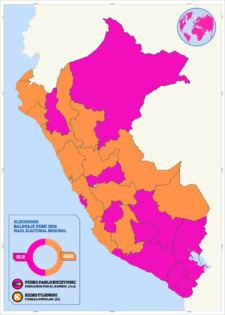10 April 2016
5 June 2016 (run off) 2021 → 8,596,937 8,555,880 Start date April 10, 2016 | 12 15 50.12% 49.88% | |
 | ||
Turnout 81.8% (first round) 1.9%
80.06% (run off) 1.74% Winner Pedro Pablo Ku | ||
France 24 sobrevilla on peru elections 2016 fujimori vs ppk
General elections took place in Peru on 10 April 2016 to determine the president, vice-presidents, composition of the Congress of the Republic of Peru and the Peruvian representatives of the Andean Parliament.
Contents
- France 24 sobrevilla on peru elections 2016 fujimori vs ppk
- Background
- Campaign highlights
- Main presidential candidates
- Other candidates
- Disqualified candidates
- Voluntarily withdrawn
- Presidential election
- Congressional election
- References
In Congress, Popular Force won in a landslide, taking more than a third of the vote and an absolute majority of 73 out of 130 seats. Behind them in opposition, Peruvians for Change with 18 seats and Broad Front with 20 seats.
In the race for the presidency, incumbent President Ollanta Humala was ineligible to run due to constitutional term limits. Popular Force candidate Keiko Fujimori, daughter of former President Alberto Fujimori, won the first round with almost 40 per cent of the vote but fell short of the 50 per cent majority required to avoid a second round. Peruvians for Change candidate Pedro Pablo Kuczynski narrowly beat Broad Front candidate Verónika Mendoza to compete in the second round, which took place on 5 June 2016. With support from those opposing Fujimori, Kuczynski overturned the first round result and won by a narrow margin of less than half a percentage point. He was sworn in as President on 28 July.
Background
The President of Peru is elected using the two-round system. The first round was held on 10 April and the second on 5 June. The 130 members of the Congress of the Republic are elected in 25 multi-member constituencies using closed list proportional representation.
On 13 November 2015, incumbent President Ollanta Humala called for a general election to be held on 10 April 2016. He said that he would respect the constitutional term limit restrictions and would not seek to run again for the presidency in this election.
Campaign highlights
President Ollanta Humala officially inaugurated the campaign in November 2015. The presidential tickets were to be inscribed by late January 10, 2016. The congressional candidacies were to be inscribed by late February 10, 2016.
In March 2016, presidential candidates Julio Guzmán from All for Peru and César Acuña Peralta from Alliance for Progress were barred from the election. The first candidate was barred due to the violation of party rules in the internal election. The second candidate was barred for giving money during a campaign trail, which is a violation of the electoral law enacted by Congress in November 2015.
Keiko Fujimori was a highly polarizing figure during the election. She is the daughter of the controversial former president Alberto Fujimori, who was sentenced to prison. She is popular among the poor people, and the loyalists who credit Fujimori with the defeat of Shining Path. This popularity allowed her to win in the first round of the presidential elections. She is resisted by the people who reject Fujimori for human rights abuses and corrupt practices, and fear that her victory would mark a return of Fujimorismo. Mendoza, who placed third and could not stand in the runoff election, gave her full support to Kuczynski, in order to prevent Fujimori's victory.
Main presidential candidates
in alphabetical order
Other candidates
The following have gained less than 5% in the last approval ratings, below the Election threshold or valla electoral.
Disqualified candidates
Voluntarily withdrawn
Presidential election
The first round was held on 10 April. Exit polls indicated that Keiko Fujimori placed first in the first round of voting with approximately 40% of the vote, with Pedro Pablo Kuczynski and Veronika Mendoza each receiving approximately 20%.
The second round was held on 5 June. Exit polls indicated that Pedro Pablo Kuczynski held a slight lead over Keiko Fujimori. As counting continued, the gap narrowed significantly. Preliminary results gave Kuczynski a 0.25 per cent advantage over Fujimori, with less than 50,000 votes between them. Approximately 50,000 votes were challenged during the count. Fujimori conceded the election to Kuczynski on 10 June.
Congressional election
Popular Force won in a landslide, taking more than a third of the vote and an absolute majority of 73 out of 130 seats. Behind them in opposition, Peruvians for Change with 18 seats and Broad Front with 20 seats. Other parties which gained representation in Congress include Alliance for the Progress of Peru (9 seats), Popular Alliance (5 seats) and Popular Action (5 seats).
